The Zapatista Rebels
"The Electronic Fabric of Struggle"
The sub-title of this section of my paper was borrowed from a chapter
written by Harry
Cleaver for an upcoming book entitled The Chiapas Uprising and the
Future of Revolution in the Twenty-First Century, edited by John Holloway.
In this chapter, Cleaver, a professor of economics at the University
of Texas at Austin and undoubtedly one of the authorities on the Chiapas
rebellion, analyzes how "The Net" has aided the Zapatistas in
bringing their message out into the world. The chapter provides an excellent
history of the proliferation of Zapatista materials on the Internet, an
overview of the effect this "appropriation of cyberspace" has
had on public opinion and an examination of what Cleaver calls "capitalist
counterattacks" on this appropriation[1].
Fortunately, the focus of Cleaver's article is sufficiently different from
the one I wish to pursue so as to avoid excessive duplication of effort.
Nevertheless, his chapter had served as one of the main sources for this
subdivision of my paper.
Who Are The Rebels?[2]
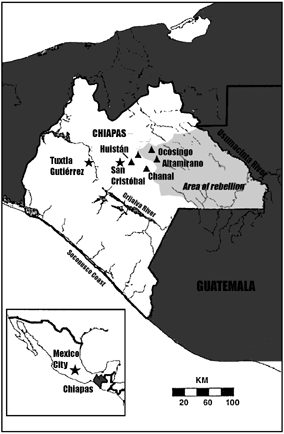 On
New Years Day, 1994, a virtually unheard-of revolutionary group calling
itself the Zapatista National Liberation Army (Ejército Zapatista
de Liberación Nacional or EZLN) took over a number of villages and
cities in the southern Mexican state of Chiapas. The group proceeded to
battle government troops until a fragile cease-fire was arranged at the
end of the month. What did these rebels fight for? To understand that question,
one must have a general idea of the economic and social conditions in Chiapas.
According to George Collier, Chiapas "lags behind the rest of Mexico
in almost every way."[3] Only
about 11% of the working population earn "moderate incomes" of
at least $3,450 per year. Running water is a luxury, and television can
be found in less than 15% of the households. At the same time, with only
3 percent of the Mexican population, Chiapas produces 13% of the country's
corn and over 50% of the hydroelectric power. Given these numbers, it is
easy to understand that most of the money funneled into the state by the
federal Mexican government is used to build roads and other infrastructure
aiding the transportation of goods from the province to the rest of the
country. The large production of corn and other foodstuffs notwithstanding,
hunger and disease run rampant among the mostly-Indian population of Chiapas,
making it one of the more dismal places in Mexico. The slogan that the
Zapatista Rebels have written on their banner is Basta ya! or "Enough
is Enough!" In their first communiqué, issued on the first
day of their uprising, the EZLN states:
On
New Years Day, 1994, a virtually unheard-of revolutionary group calling
itself the Zapatista National Liberation Army (Ejército Zapatista
de Liberación Nacional or EZLN) took over a number of villages and
cities in the southern Mexican state of Chiapas. The group proceeded to
battle government troops until a fragile cease-fire was arranged at the
end of the month. What did these rebels fight for? To understand that question,
one must have a general idea of the economic and social conditions in Chiapas.
According to George Collier, Chiapas "lags behind the rest of Mexico
in almost every way."[3] Only
about 11% of the working population earn "moderate incomes" of
at least $3,450 per year. Running water is a luxury, and television can
be found in less than 15% of the households. At the same time, with only
3 percent of the Mexican population, Chiapas produces 13% of the country's
corn and over 50% of the hydroelectric power. Given these numbers, it is
easy to understand that most of the money funneled into the state by the
federal Mexican government is used to build roads and other infrastructure
aiding the transportation of goods from the province to the rest of the
country. The large production of corn and other foodstuffs notwithstanding,
hunger and disease run rampant among the mostly-Indian population of Chiapas,
making it one of the more dismal places in Mexico. The slogan that the
Zapatista Rebels have written on their banner is Basta ya! or "Enough
is Enough!" In their first communiqué, issued on the first
day of their uprising, the EZLN states:
But today, we say ENOUGH IS ENOUGH. We are the inheritors of the
true builders of our nation. The dispossessed, we are millions and we thereby
call upon our brothers and sisters to join this struggle as the only path,
so that we will not die of hunger due to the insatiable ambition of a 70
year dictatorship led by a clique of traitors that represent the most conservative
and sell-out groups.[4]
The mentioned "clique of traitors" refers to none other than
the Mexican government, led by the PRI or Party of Institutionalized Revolution,
a group that has ruled Mexico since shortly after the 1910 revolution.
Calling the PRI "traitors" might not be an exaggeration on the
part of the Zapatista propaganda. As recently as 1992, the Mexican government
changed Article 27 of the Mexican constitution, a document written after
the Revolution in 1917 and realizing many of the ideas and ideals of Emiliano
Zapata and others. The change to Article 27 repealed a land reform and
thus "robbed many peasants not just of the possibility of gaining
a piece of land, but, quite simply, of hope."[5]
(A Spanish copy of the Mexican
constitution is available on-line; Article 27 is part of Chapter
I) The PRI, calling itself the heir to the Mexican Revolution, has
long since forsaken the true principles Zapata, Villa and others fought
for. As we have examined before, Emiliano Zapata cannot be called a communist
revolutionary. The modern Zapatistas also have been regarded by many
as communists. It is, however, very hard to box the EZLN's ideology into
a traditional category. Some statements regarding their alleged communism:
In a January 19, 1994, interview with Zapatista leader Subcomandante
Marcos:
We do not want a dictatorship of another kind, nor anything out of
this world, not international Communism and all that. We want justice where
there is now not even minimum subsistence.[6]
In an Interview with the "Clandestine Revolutionary Indigenous
Committee" -- the Zapatistas' leadership council:
Question: In this sense, the Zapatista movement and the Zapatista
revolution have been called the first post-modernist revolution. Now, let's
analyze the fact that many current theories of the new left, of an anti-authoritarian
left with a definite tendency toward libertarian communism, break with
the blueprint that sees the working class as the vanguard of the social
revolution. Many of these new theories even see the working class as a
class in decline, a class that does not recognize itself as a class, a
class that less and less wants to be considered the working class. Is this
conception of the working class one that you have adopted during your experiences?
Marcos: No, definitely not. Those idols against which we were fighting
were different. The idea that armed struggle was possible in all places
except Mexico was so omnipresent that we were obligated to confront it
first and leave the rest for later. Beyond this, in historical or theoretical
terms, who would have speculated before December 31, 1993 that it wasn't
going to be the proletariat leading the revolution? Then who? Who was it
going to be? They could have speculated that it would be the teachers,
they could have speculated that it would be the unemployed, they could
have speculated that it would be the students or some sector of the middle
class, they could have speculated that it would be leftist or democratic
factions within the Federal Army or within the supposedly democratic faction
of the PRI. They could have speculated many things, including that the
United States would become socialist and then they would invade us and
make us socialists [laughter]. This was the reasoning then. Even in the
university this idea had taken root.[7]
Harry Cleaver points out that to be called "communist" in
the traditional sense is offensive to the Zapatistas. According to his
introduction to Zapatistas! the EZLN "explicitly rejected the
traditional Leninist objectives of 'taking power,' 'the dictatorship of
the proletariat,' 'international communism' and 'all that.'"[8]
Nevertheless, the question of whether one can call these rebels communists
or maybe neo-communists might never be settled.
An even more interesting question might be whether these rebels truly
are "Zapatistas," i.e. followers of Emiliano Zapata. There are
countless references to Zapata in EZLN writings, especially to the Plan
of Ayala, Zapata's redistribution plan for some of the hacienda
properties and his conditions for laying down arms. When asked to explain
the foundation of Zapatista ideology and the structural basis of the movement,
Subcomandante Marcos explains that the roots of the organization lie with
the Latin American guerrilla movements of the 1960s and 1970s. The EZLN
began as a grass-roots organization of indigenous Indians who were disillusioned
because nonviolent and non-revolutionary struggle would not lead to a betterment
of their living situation. Thus, Marcos says, they arrived at the conclusion
that armed struggle was necessary. Interestingly, when Zapatista supporters
first began mentioning the need for a revolution, much of the Mexican left
disagreed, according to Marcos, and held that revolution "wasn't Mexico's
role,"[9] that any change
could only be brought about by peaceful methods, partially because of the
proximity to the United States.
Marcos uses the metaphor of a "wall" between the cities of
Mexico and the jungle, with the wall representing the mountains of southern Mexico.
It is this wall that has kept indigenous Mexicans from political power;
but it is also the same wall that allowed the modern Zapatista movement
to grow clandestinely and gain strength without the Mexican authorities
realizing it. While the Zapatistas approached the struggle from a more
ideological standpoint, the native population saw things in a more practical
light. Says Marcos: "Then, we found each other and we began to speak
in two different languages, but in this common point of necessity of armed
struggle a relationship began to develop. They needed military instruction,
and we needed the support of a social base. And we thus tried to convince
them of the necessity of a broader political project."[10]
This mixing of a guerrilla army and an indigenous population led
to a new ideology and new vision of government. Marcos calls it a "democratic
collective," a form of government where positions are filled by community
appointment -- one must assume this means a form of election -- and are
of indefinite term. The community has the right to remove a person from
a position at any time. Leaders would have a chance to defend their actions
before the community and the majority would eventually decide whether a
person remains in that position or not. Marcos likens this to student assemblies,
a horizontal rather than vertical structure of assigning power or positions.
One could debate for a long time whether the EZLN is a communist guerrilla
army or not. They are certainly not a worker movement, and nowhere in their
writings would one find the idea of a supreme proletariat. There is no
doubt that they are an "Indianist" movement, fighting mainly
for the indigenous people of southern Mexico. This represents a break from the tradition
of Zapata, who was less concerned with race and more concerned with class.
| The
Zapatistas in Brief |
| Demands |
The Eleven Points (a list of demands often repeated in Zapatista writings):
| Work |
Land |
Shelter |
Food |
Health |
Education |
| Autonomy |
Freedom |
Democracy |
Justice |
Peace |
More specifically, demands include a transition to a true democracy
in Mexico, an agrarian reform, curbing the wealth and power of large landholders,
assistance for the indigenous population, an end to discrimination against
Indians, etc.
|
| Ideology |
"Post-Modern," i.e. rejecting the claim of exclusiveness of
any specific ideology or belief system. Elements of socialism and Marxism,
but also "Indianist" and traditional guerrilla elements |
| Leadership |
Apparently lead by "Subcomandante Marcos" and a leadership
council known as the "Clandestine Indigenous Revolutionary Committee
-- General Command" |
Since the second anniversary of the uprising was celebrated in 1996,
the EZLN has become much more conciliatory, forming a political wing that
will challenge the government with nonviolent means. "'The struggle
we launched the first of January of 1994 is entering a new phase,' he [Marcos]
said. 'The EZLN (the rebel group) will not disappear, but its most important
struggles will be waged in the political arena.'"[11]
The government, however, has not reciprocated this dealing and has continued
to pursue the Zapatistas with military force as recently as February of
1996.
 No
discussion of the Zapatistas would be complete without a short sketch of
Subcomandante Marcos, their military leader. Appearing in public only behind
a skimask, Marcos is surrounded by almost as much mystique as Emiliano
Zapata. While the Mexican government claims they have identified him, the
Zapatistas argue that, whatever his former identity may have been, it is
of no relevance now. It must come as a surprise that Marcos is not an indigenous
Mexican but rather either a mestizo or a man of Spanish decent. While he
does not sit in the "Clandestine Indigenous Revolutionary Committee"
it is not at all clear if he merely follows their orders or makes policy.
No
discussion of the Zapatistas would be complete without a short sketch of
Subcomandante Marcos, their military leader. Appearing in public only behind
a skimask, Marcos is surrounded by almost as much mystique as Emiliano
Zapata. While the Mexican government claims they have identified him, the
Zapatistas argue that, whatever his former identity may have been, it is
of no relevance now. It must come as a surprise that Marcos is not an indigenous
Mexican but rather either a mestizo or a man of Spanish decent. While he
does not sit in the "Clandestine Indigenous Revolutionary Committee"
it is not at all clear if he merely follows their orders or makes policy.
It is apparent from Marcos' writings that he is a very well-educated
and well-read individual. His sarcasm is biting, his wit is sharp, and
his knowledge of Mexican history, world affairs, and ideologies begs the
conclusion that he is university-educated. Recently, Marcos has been quoted
as wanting to change the EZLN from a rebel movement to a political force
in Mexico. When a group calling itself the "Popular Revolutionary
Army" appeared on the Mexican political scene in July of 1996, Marcos
distanced himself and his organization from the new group, which is calling
for violence against the government.
Has the Mexican government succeeded in silencing and co-opting the
Zapatistas? It appears doubtful to me, but I am certain the Zapatista situation
in Mexico will remain interesting for some time to come.
[Note: For more information on the events surrounding the Zapatista
rebellion in 1994, see the Zapatista
Timeline.]
The Media Hype
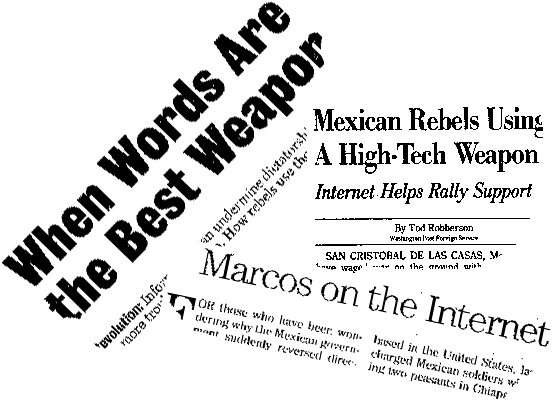 The
Zapatista rebellion has been called "post-modern" because of
its lack of a clear traditional ideological direction. While it was fought at times with comparatively primitive weapons such as WW2 rifles, the
Zapatista uprising is the first major political upheaval that has been
extensively covered, commented on, and reported on the Internet. Further
than that, the Zapatistas and their supporters have used and continue to
use the Internet to broadcast their version of what is happening in Chiapas,
bypassing the national Mexican media, largely controlled by the PRI government.
This essentially new form of distributing revolutionary material caught
the eye of many journalists who promptly reported on this "cyberspace
war." A Mexican newspaper, La Jornada, reports that Mexican
officials have begun referring to the uprising as la guerra de tinta
e Internet or the War of Ink and Internet.
The
Zapatista rebellion has been called "post-modern" because of
its lack of a clear traditional ideological direction. While it was fought at times with comparatively primitive weapons such as WW2 rifles, the
Zapatista uprising is the first major political upheaval that has been
extensively covered, commented on, and reported on the Internet. Further
than that, the Zapatistas and their supporters have used and continue to
use the Internet to broadcast their version of what is happening in Chiapas,
bypassing the national Mexican media, largely controlled by the PRI government.
This essentially new form of distributing revolutionary material caught
the eye of many journalists who promptly reported on this "cyberspace
war." A Mexican newspaper, La Jornada, reports that Mexican
officials have begun referring to the uprising as la guerra de tinta
e Internet or the War of Ink and Internet.
Most articles written in the US have focused on the novelty of having
a revolutionary group in a country that some consider to be "Third
World" or at least "developing" using the most talked-about
new technology of the late 20th century. In a somewhat conceited manner,
some reporters -- who must have expected the Zapatistas to fight with sticks
and stones and smoke signals -- demonstrated their surprise at this appropriation
of the Internet. Not all reporters abstained from romanticizing and probably
exaggerating the extent and manner in which the rebels themselves have
accessed the Internet. A Christian
Science Monitor editorial reports that "Marcos, it turns out,
is on-line. Punching out communiqués on a lap-top computer powered
from the cigarette lighter in his car, and then passing them along via
modem and cellular phone"[12].
It seems rather doubtful that Marcos actually accesses the Internet personally
to upload the newest communiqués or maybe to check on the latest
world news about his army. Harry Cleaver, who certainly speaks with some
authority, asserts that "Subcomandante Marcos is not sitting in some
jungle camp uploading EZLN communiqués via mobile telephone modem
directly to the Internet. Zapatista messages have to be hand-carried through
the lines of military encirclement and uploaded by others to the networks
of solidarity."[13] Nonetheless,
the information is getting out and various supporters around the world
have put up WWW sites to distribute EZLN information, out of the reach
of the Mexican government censors.
The German writer Goethe
mocks in his masterwork Faust,
"Because what one has down in black and white / It is a comfort to
take home at night." Unfortunately, in a world where anybody can publish
"authoritative" materials on the Internet, one must be careful
not to take all that information at face value. In an article called "Mexican
Rebels Using A High-Tech Weapon," Tod Robberson of the Washington
Post points out that some of the material distributed on the Internet,
allegedly by the Zapatistas, does not reflect the true situation in Chiapas.
"One user group here sent out a report that airborne bombardments
were underway in several named mountain villages and urged an international
protest. They passed on rebel assertions that women were being raped and
children killed. But reporters who visited those areas and interviewed
scores of witnesses said they were unable to confirm even one such incident."[14]
Nevertheless, most of the information on-line appears to be genuine.
The Sites
What is actually out there? It would be impossible to list every Internet
site that mentions the Zapatista Rebels. An AltaVista
Web search
for "zapatista*" (which returns all documents that contain
words beginning with "zapatista" -- this allows catching the
singular and plural of the word) returned over 3000 pages. In the following
section, I will examine a select number of Web sites dealing exclusively
with the Zapatistas, as well as some sites that mention their cause or
are otherwise related to the subject.
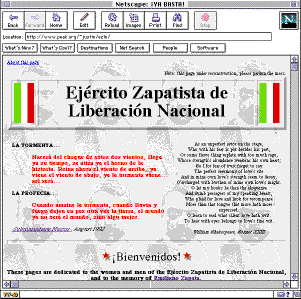 |
¡YA
BASTA!
Ejército Zapatista de Liberación Nacional
|
The most complete page on the Zapatista movement to date, ¡Ya
Basta! is deservedly one of Lycos
Web Point's top 5% of WWW sites. It contains a regularly updated archive
of the communiqués of the EZLN, many of which have been translated
into English, some even into other languages such as German. While that
list is not complete, all communiqués are HTML-formatted and easy
to read or print. A more complete archive, albeit a text-only one, can
be found as part of the Chiapas95
mailing list archives. The site provides an invaluable research tool
for all who are interested in the Zapatista Rebels. Students who wish to
research this topic can find a plethora of primary source information which
would otherwise be impossible to track down. Apart from original Zapatista
writings, there is a large number of news stories and related information
chronicling the rebellion, government responses, and negotiations.
This site is by no means nonpartisan. On the contrary, Paulson clearly
supports the Zapatistas and wants his site to "serve as a mouthpiece
for the Zapatistas in cyberspace." There is a section titled "How
you can help" which lists various ways for those who are interested
in activism to get involved in helping the Zapatistas and the people of
Chiapas. Possibilities range from writing letters to Mexican officials
and lobbying US congressmen to participating in a "peace encampment"
in Chiapas or simply helping out with the maintenance of the web page.
Naturally, any kind of partisanship will find its detractors and Web Point's
reviewer did not take kindly to the lack of even-handedness in Paulson's
page:
This unofficial page of the Mexican guerrilla movement (by Swarthmore
student Justin Paulson) certainly means well. And there's nothing amusing
about war. Yet the page conjures images of Woody Allen's movie classic
Bananas by simultaneously condemning and condoning violence: "The
Zapatistas... have made every possible move to minimize violence while
not compromising their position." ... Info's in English and Spanish,
and there are official EZLN communiqués and black and white photos
of the leaders in full black-ski-mask regalia.[15]
The mentioned photos, which are hard to find among the various pages,
include the image of Subcomandante Marcos which I have included in this
page. While the criticism of Paulson's page may be valid, it still provides
one of the most useful research tool on the Zapatistas, on or off the WWW.
The amount of non-original propaganda written by people other than the rebels
is at a minimum, and Paulson reports that his site receives a
large number of "hits" (Internet-slang for times accessed) from
within Mexico, proving that it is allowing Mexicans with Internet access
to circumvent the censorship in their media and receive first-hand Zapatista
writings and information.
Acción Zapatista
takes a somewhat different approach to the presentation of the Zapatista
rebellion. While Justin Paulson's page contains a fair amount of propaganda,
this WWW site is composed of little else. The creators, who only identify
themselves as Acción Zapatista de Austin (with included
e-mail and traditional mail addresses), do not hide their partisanship. In
their self-description they write:
Acción Zapatista is an organization that gathers and redistributes
information about the Zapatistas and the struggle for democracy in Mexico.
We protest US support of the Mexican government, and support local struggles
that challenge neoliberal policies and institutions. Because events in
different regions are related by the brutal logic of global capital, we
invite your input in developing new strategies of organizing and an ongoing
understanding of the interconnections between local and international struggles.
Acción Zapatista maintains a communications network designed
to link local struggles. The AZ network allows individuals and organizations
to collaborate with us via the Internet in order to participate in debate,
post important information, request relevant data, present opinions and
insights and be informed of upcoming events or actions in the Austin area.[16]
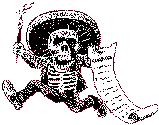 Some
of the features of this WWW site that are not included in ¡Ya
Basta! include a short
history of the Zapatista movement (albeit not a neutral one) and El
Paliacate, an electronic newsletter which includes yet more copies
of the Zapatistas' communiqués in addition to analysis and commentary
written by supporters. One of the most interesting aspects to this page
is an essay called "Exposing
Neoliberalism" which is available in both English and Spanish.
The well-laid-out essay argues against the resurgence of neoliberalism a restoration of classical liberalism which is the foundation of capitalism, according to the author. Or, According to Don
Durito (Subcomandante Marcos' pet beetle) neoliberalism is "the chaotic theory
of economic chaos, the stupid exaltation of social stupidity, and the catastrophic
political management of catastrophe." Durito is a vehicle Marcos uses
to explain the Zapatista goal of fighting this perceived "neoliberalism"
and conversations with the beetle are a frequent part of the Zapatista
communiqués. Incidentally, Don
Durito has his own WWW page which includes HTML versions
of his stories and a number of original illustrations. Another collection
of essays and articles on neoliberalism can be found at "Initiatives
against Neoliberalism," an extensive archive of writings in English,
Spanish and German, located on a WWW server in Berlin, Germany.
Some
of the features of this WWW site that are not included in ¡Ya
Basta! include a short
history of the Zapatista movement (albeit not a neutral one) and El
Paliacate, an electronic newsletter which includes yet more copies
of the Zapatistas' communiqués in addition to analysis and commentary
written by supporters. One of the most interesting aspects to this page
is an essay called "Exposing
Neoliberalism" which is available in both English and Spanish.
The well-laid-out essay argues against the resurgence of neoliberalism a restoration of classical liberalism which is the foundation of capitalism, according to the author. Or, According to Don
Durito (Subcomandante Marcos' pet beetle) neoliberalism is "the chaotic theory
of economic chaos, the stupid exaltation of social stupidity, and the catastrophic
political management of catastrophe." Durito is a vehicle Marcos uses
to explain the Zapatista goal of fighting this perceived "neoliberalism"
and conversations with the beetle are a frequent part of the Zapatista
communiqués. Incidentally, Don
Durito has his own WWW page which includes HTML versions
of his stories and a number of original illustrations. Another collection
of essays and articles on neoliberalism can be found at "Initiatives
against Neoliberalism," an extensive archive of writings in English,
Spanish and German, located on a WWW server in Berlin, Germany.
Acción Zapatista is also the home for the "Zapatismo
Communications Network," an Internet e-mail list linking supporters
of the Zapatistas together and allowing the exchange of information via
electronic mail. One of the main concerns of this list is the Red Intercontinental
de Comunicación Alternativa (Intercontinental Network of Alternative
Communication) or RICA.
This proposed network would link together WWW sites, mailing lists, and
other on-line elements and unite them in the struggle against neoliberalism.
It will be interesting to see if RICA ever goes beyond the planning stage
and, if so, what form it will eventually take. Once established, such a
network would certainly have to be included in any discussion of the Zapatista
presence on the Internet.
Overall, Acción Zapatista is a WWW site calling for action
and support, such as a drive for food and money donations, for the Zapatista
rebels. One of the most valuable services provided is a list
of links to other Zapatista and social activism sites.
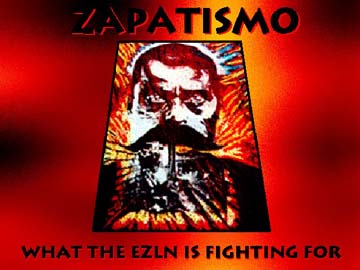 Zapnet
follows a somewhat different approach to bringing the Zapatista message
to the users of the Internet. This site is part of the "The Advanced
Communication Technologies Laboratory" or ACTlab,
once again at the University of Texas. The "About
the ACTlab" page describes this endeavor, a venture of the Department
of Radio, Television and Film like this: "We are a freewheeling
research facility for advanced work at the boundaries where technology,
art, and culture collide." Zapnet was designed by a group of multimedia
students and its emphasis clearly lies less with the distribution of Zapatista
material but with the stylish and "cyberspacial" presentation
of the material. This is a rather large site, with various sections presenting
different aspects of the struggle. To fully appreciate the multimedia aspects
of Zapnet, one must use a frames-capable WWW browser and have the Macromedia
Shockwave Plug-In.
Zapnet
follows a somewhat different approach to bringing the Zapatista message
to the users of the Internet. This site is part of the "The Advanced
Communication Technologies Laboratory" or ACTlab,
once again at the University of Texas. The "About
the ACTlab" page describes this endeavor, a venture of the Department
of Radio, Television and Film like this: "We are a freewheeling
research facility for advanced work at the boundaries where technology,
art, and culture collide." Zapnet was designed by a group of multimedia
students and its emphasis clearly lies less with the distribution of Zapatista
material but with the stylish and "cyberspacial" presentation
of the material. This is a rather large site, with various sections presenting
different aspects of the struggle. To fully appreciate the multimedia aspects
of Zapnet, one must use a frames-capable WWW browser and have the Macromedia
Shockwave Plug-In.
It is hard to describe this site without using somewhat pejorative terms
such as "artsy" or "pretentious," but all parts of
this project clearly show that their parentage lies with art or multimedia
students (a well-designed overview of the available material is provided
in the Zapnet
Site Guide). There is a plethora of images and animations, including
some rather colorful ones about Subcomandante Marcos in a section called
"The
Revolution Will Be Digitised." Other multimedia aspects include
sounds and quick-time movies,
mainly video clips taken from commercially available materials on the Zapatistas.
Without a doubt, Zapnet is the most colorful WWW-page on the Zapatistas
and one of the most multimedia-intensive non-commercial sites
on Internet. Zapnet is most likely not a very rich research tool for traditional
investigators, but for those looking for non-text-based information Zapnet,
with its emphasis on technology and "cyberspace", has a lot to
offer.
One of the most noteworthy features of the Zapnet is its "Wall
of Autonomy," a page where visitors to the site can leave comments
or suggestions readable by all. This allows for a degree of user interaction
not seen on other sites. It is often worth the time, just to stop by and check
for new contributions.
Other sites
As mentioned before, the number of sites dealing with or mentioning
the Zapatistas and their cause is large and constantly growing.
To provide a better tool for those researching the EZLN, I have picked
a number of other Internet sites which are useful and/or simply interesting
in relation to the Zapatistas but which have not been directly mentioned in
my writing. Some of these sites may not mention the Zapatistas directly,
but they provide useful background material to understand the situation
in Chiapas, Mexico, or the developing world as a whole.
- The National Commission for
Democracy in Mexico, USA -- According to their WWW site, this is the
"structure recognized by the EZLN for coordinating support in the
United States." There is a link to a gopher-based archive of NCDM
writings as well as membership information.
 Homepage
of the PRI -- This site is a minor orgy of self-promotion for the Mexican
ruling party, the PRI. A "must" for all interested in Mexico
and the Mexican political and electoral processes. This Web site contains
an extensive history of the party from 1929 to the present as well as interviews
with party and government officials, policy statements, and party platform
papers.
Homepage
of the PRI -- This site is a minor orgy of self-promotion for the Mexican
ruling party, the PRI. A "must" for all interested in Mexico
and the Mexican political and electoral processes. This Web site contains
an extensive history of the party from 1929 to the present as well as interviews
with party and government officials, policy statements, and party platform
papers. - Chiapas
95 Homepage -- Harry Cleaver's page for the Chiapas 95 mailing list
contains links to the list archives as well as various articles written
by him and other contributors.
- Centro Bilingue de Chiapas
-- A language school located in San Cristóbal de las Casas, incidentally
the first city to be taken by the Zapatistas during their rebellion. This
might be a good way to get to know the region and its people -- traveling
or studying in a state with an active guerrilla movement is, however, not
recommended for the faint-hearted.
- Rage Against the Machine -- The
alternative rock band has written the names of number of causes on their banner, including
the EZLN. This site is a good example on how pop culture on the Internet
has appropriated political causes. Nothing is safe from merchandising;
as an example, see one of the Rage Against the Machine T-shirts.
Note: Citations from the main Zapatista Internet sites discussed in
the project are cited in-line with the main text; hyperlinks point directly
at the sources. There are also bibliography entries
for these sites.
[1] see Cleaver,
Harry. The Zapatistas and the Electronic Fabric of Struggle.
[2] Factual information about
the Chiapas uprising taken from Cleaver,
Collier, and Paulson as well as
the various Zapatista documents made available on the Internet (see in-line
citations). Image of Subcomandante Marcos from ¡Ya
Basta! Map of Chiapas source: Collier.
[3] Collier,
p. 16.
[4] see First
declaration from the Lacandon jungle by the Zapatista Army of National
Liberation.
[5] Collier,
p. 45.
[6] from Cleaver
this section on-line at: gopher://lanic.utexas.edu:70/00/la/Mexico/Zapatistas/01
[7] ibid.
this section on-line at: gopher://lanic.utexas.edu:70/0R0-113502-/la/Mexico/Zapatista
s/11.TXT
[8] ibid.
this introduction on-line at: gopher://lanic.utexas.edu:70/0R0-43346
-/la/Mexico/Zapatistas/INTRO.TXT
[9] see footnote [7]
[10] ibid.
[11] from a report by CNN's
Lucia Newman
[12] from Christian
Science Monitor, "Marcos
on the Internet"
[13] see footnote [1].
[14] Robberson.
[15] Web
Point, Review of ¡Ya
Basta!
 On
New Years Day, 1994, a virtually unheard-of revolutionary group calling
itself the Zapatista National Liberation Army (Ejército Zapatista
de Liberación Nacional or EZLN) took over a number of villages and
cities in the southern Mexican state of Chiapas. The group proceeded to
battle government troops until a fragile cease-fire was arranged at the
end of the month. What did these rebels fight for? To understand that question,
one must have a general idea of the economic and social conditions in Chiapas.
According to George Collier, Chiapas "lags behind the rest of Mexico
in almost every way."[3] Only
about 11% of the working population earn "moderate incomes" of
at least $3,450 per year. Running water is a luxury, and television can
be found in less than 15% of the households. At the same time, with only
3 percent of the Mexican population, Chiapas produces 13% of the country's
corn and over 50% of the hydroelectric power. Given these numbers, it is
easy to understand that most of the money funneled into the state by the
federal Mexican government is used to build roads and other infrastructure
aiding the transportation of goods from the province to the rest of the
country. The large production of corn and other foodstuffs notwithstanding,
hunger and disease run rampant among the mostly-Indian population of Chiapas,
making it one of the more dismal places in Mexico. The slogan that the
Zapatista Rebels have written on their banner is Basta ya! or "Enough
is Enough!" In their first communiqué, issued on the first
day of their uprising, the EZLN states:
On
New Years Day, 1994, a virtually unheard-of revolutionary group calling
itself the Zapatista National Liberation Army (Ejército Zapatista
de Liberación Nacional or EZLN) took over a number of villages and
cities in the southern Mexican state of Chiapas. The group proceeded to
battle government troops until a fragile cease-fire was arranged at the
end of the month. What did these rebels fight for? To understand that question,
one must have a general idea of the economic and social conditions in Chiapas.
According to George Collier, Chiapas "lags behind the rest of Mexico
in almost every way."[3] Only
about 11% of the working population earn "moderate incomes" of
at least $3,450 per year. Running water is a luxury, and television can
be found in less than 15% of the households. At the same time, with only
3 percent of the Mexican population, Chiapas produces 13% of the country's
corn and over 50% of the hydroelectric power. Given these numbers, it is
easy to understand that most of the money funneled into the state by the
federal Mexican government is used to build roads and other infrastructure
aiding the transportation of goods from the province to the rest of the
country. The large production of corn and other foodstuffs notwithstanding,
hunger and disease run rampant among the mostly-Indian population of Chiapas,
making it one of the more dismal places in Mexico. The slogan that the
Zapatista Rebels have written on their banner is Basta ya! or "Enough
is Enough!" In their first communiqué, issued on the first
day of their uprising, the EZLN states:  No
discussion of the Zapatistas would be complete without a short sketch of
Subcomandante Marcos, their military leader. Appearing in public only behind
a skimask, Marcos is surrounded by almost as much mystique as Emiliano
Zapata. While the Mexican government claims they have identified him, the
Zapatistas argue that, whatever his former identity may have been, it is
of no relevance now. It must come as a surprise that Marcos is not an indigenous
Mexican but rather either a mestizo or a man of Spanish decent. While he
does not sit in the "Clandestine Indigenous Revolutionary Committee"
it is not at all clear if he merely follows their orders or makes policy.
No
discussion of the Zapatistas would be complete without a short sketch of
Subcomandante Marcos, their military leader. Appearing in public only behind
a skimask, Marcos is surrounded by almost as much mystique as Emiliano
Zapata. While the Mexican government claims they have identified him, the
Zapatistas argue that, whatever his former identity may have been, it is
of no relevance now. It must come as a surprise that Marcos is not an indigenous
Mexican but rather either a mestizo or a man of Spanish decent. While he
does not sit in the "Clandestine Indigenous Revolutionary Committee"
it is not at all clear if he merely follows their orders or makes policy.
 The
Zapatista rebellion has been called "post-modern" because of
its lack of a clear traditional ideological direction. While it was fought at times with comparatively primitive weapons such as WW2 rifles, the
Zapatista uprising is the first major political upheaval that has been
extensively covered, commented on, and reported on the Internet. Further
than that, the Zapatistas and their supporters have used and continue to
use the Internet to broadcast their version of what is happening in Chiapas,
bypassing the national Mexican media, largely controlled by the PRI government.
This essentially new form of distributing revolutionary material caught
the eye of many journalists who promptly reported on this "cyberspace
war." A Mexican newspaper, La Jornada, reports that Mexican
officials have begun referring to the uprising as la guerra de tinta
e Internet or the War of Ink and Internet.
The
Zapatista rebellion has been called "post-modern" because of
its lack of a clear traditional ideological direction. While it was fought at times with comparatively primitive weapons such as WW2 rifles, the
Zapatista uprising is the first major political upheaval that has been
extensively covered, commented on, and reported on the Internet. Further
than that, the Zapatistas and their supporters have used and continue to
use the Internet to broadcast their version of what is happening in Chiapas,
bypassing the national Mexican media, largely controlled by the PRI government.
This essentially new form of distributing revolutionary material caught
the eye of many journalists who promptly reported on this "cyberspace
war." A Mexican newspaper, La Jornada, reports that Mexican
officials have begun referring to the uprising as la guerra de tinta
e Internet or the War of Ink and Internet.
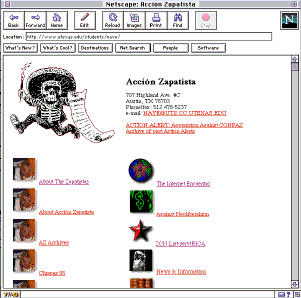
 Some
of the features of this WWW site that are not included in ¡Ya
Basta! include a
Some
of the features of this WWW site that are not included in ¡Ya
Basta! include a 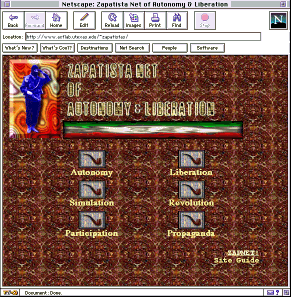
 Zapnet
follows a somewhat different approach to bringing the Zapatista message
to the users of the Internet. This site is part of the "The Advanced
Communication Technologies Laboratory" or
Zapnet
follows a somewhat different approach to bringing the Zapatista message
to the users of the Internet. This site is part of the "The Advanced
Communication Technologies Laboratory" or 